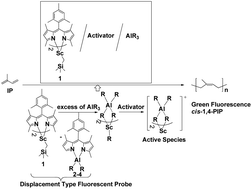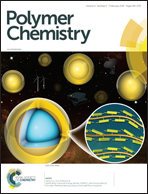A displacement-type fluorescent probe reveals active species in the coordinative polymerization of olefins†
Abstract
The correct identification of active species is an important prerequisite to study the mechanism of coordinative polymerization of olefins, which can afford important theoretical guidance for the design and synthesis of new organometallic catalysts and high-performance polyolefin materials. However, it is very difficult to isolate and identify the catalytically active species generated from organometallic complex/activator/AlR3 ternary systems during the coordinative polymerization of olefins. Herein, we present a new strategy to detect the catalytically active species in the coordination polymerization of olefins through the utilization of a displacement-type fluorescent probe containing an organometallic complex and an aluminum alkyl complex bearing the same chelating ligand. Using fluorescence spectroscopy and in situ1H NMR spectroscopy, the truly active species is identified and a plausible mechanism is proposed, which provides new insights into the cis-1,4-polymerization of isoprene catalyzed by rare earth metal monoalkyl complex/activator/AlR3 ternary systems.



 Please wait while we load your content...
Please wait while we load your content...